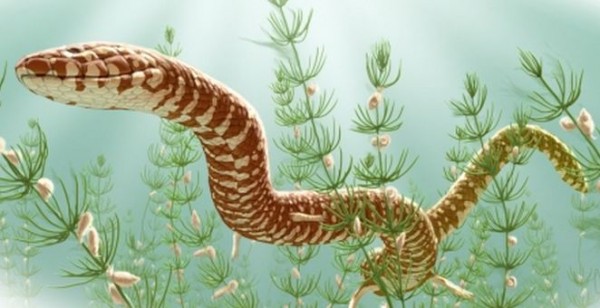World's Oldest Prehistoric Snake Discovered
| Marco Foronda | | Jan 28, 2015 05:05 AM EST |
An artist's concept of a prehistoric snake
Scientists have discovered what may be the oldest known snake fossils. The fossils are estimated to be from 143 and 167 million years old, and could possibly push back the evolutionary origins of these legless reptiles, according to new research.
A team of scientists from the University of Alberta said the findings could help change the way researchers look at how or when modern snakes developed.
Like Us on Facebook
These latest fossilized remains of four ancient snake species found in England, Portugal and the United States could be as much as nearly 70 million years older compared to previous studies that say the oldest remains of snakes were from around 100 million years ago.
"The study explores the idea that evolution within the group called 'snakes' is much more complex than previously thought. Importantly, there is now a significant knowledge gap to be bridged by future research, as no fossils snakes are known from between 140 to 100 million years ago," said study leader Michael Caldwell from the University of Alberta in Canada.
Previous studies have concluded snake evolution is more complicated than previously thought. It stated the snake's characteristic long, thin skull structure evolved after the animals became legless, which is also when they developed their elongated bodies.
The new finding show the sudden appearance of snakes about 100 million years ago signifies a gap in the fossil record as opposed to an "explosive radiation of early snakes".
Researchers noted a number of fossilized skulls previously associated with other non-snake lizard remains may actually be from the earliest days of the reign of snakes.
Caldwell stumbled upon and identified one of the four ancient snake species in 2004 at the Natural History Museum in London. Parviraptor estesi, dating back 143 million years ago, is the youngest of the specimens this study describes.
Though the remains are only fragmentary, and reveal little information about the reptile's overall shape, length or body form, researchers can tell its skull anatomy is similar to that of modern snakes.
Detailed information of the new study was published in the journal, Nature Communications.
TagsFossil, snake, evolution, ancient snake, Parviraptor estesi, snake fossils
©2015 Chinatopix All rights reserved. Do not reproduce without permission
EDITOR'S PICKS
-

Did the Trump administration just announce plans for a trade war with ‘hostile’ China and Russia?
-

US Senate passes Taiwan travel bill slammed by China
-

As Yan Sihong’s family grieves, here are other Chinese students who went missing abroad. Some have never been found
-

Beijing blasts Western critics who ‘smear China’ with the term sharp power
-

China Envoy Seeks to Defuse Tensions With U.S. as a Trade War Brews
-

Singapore's Deputy PM Provides Bitcoin Vote of Confidence Amid China's Blanket Bans
-

China warns investors over risks in overseas virtual currency trading
-

Chinese government most trustworthy: survey
-

Kashima Antlers On Course For Back-To-Back Titles
MOST POPULAR
LATEST NEWS
Zhou Yongkang: China's Former Security Chief Sentenced to Life in Prison

China's former Chief of the Ministry of Public Security, Zhou Yongkang, has been given a life sentence after he was found guilty of abusing his office, bribery and deliberately ... Full Article
TRENDING STORY

China Pork Prices Expected to Stabilize As The Supplies Recover

Elephone P9000 Smartphone is now on Sale on Amazon India

There's a Big Chance Cliffhangers Won't Still Be Resolved When Grey's Anatomy Season 13 Returns

Supreme Court Ruled on Samsung vs Apple Dispute for Patent Infringement

Microsoft Surface Pro 5 Rumors and Release Date: What is the Latest?










